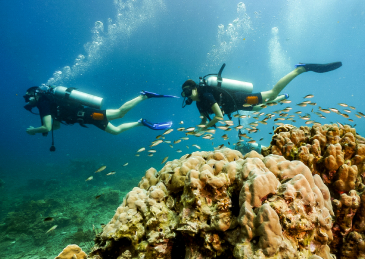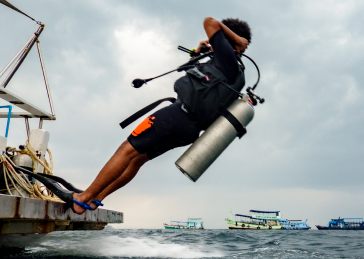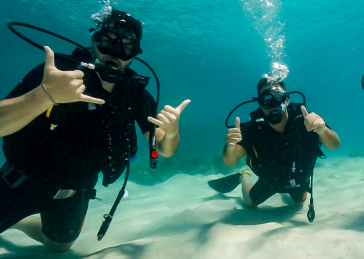Modified 9th June 2025
Essential Scuba Diving Gear: Complete Equipment Guide for Safe and Comfortable Diving
Whether you’re newly certified or considering this incredible sport, understanding essential scuba diving gear is crucial for both safety and enjoyment underwater. The right equipment not only keeps you safe but transforms you from a land-dweller into a confident underwater explorer.
This comprehensive guide covers everything you need to know about selecting, using, and maintaining your diving equipment for years of safe underwater adventures in destinations like Koh Tao.
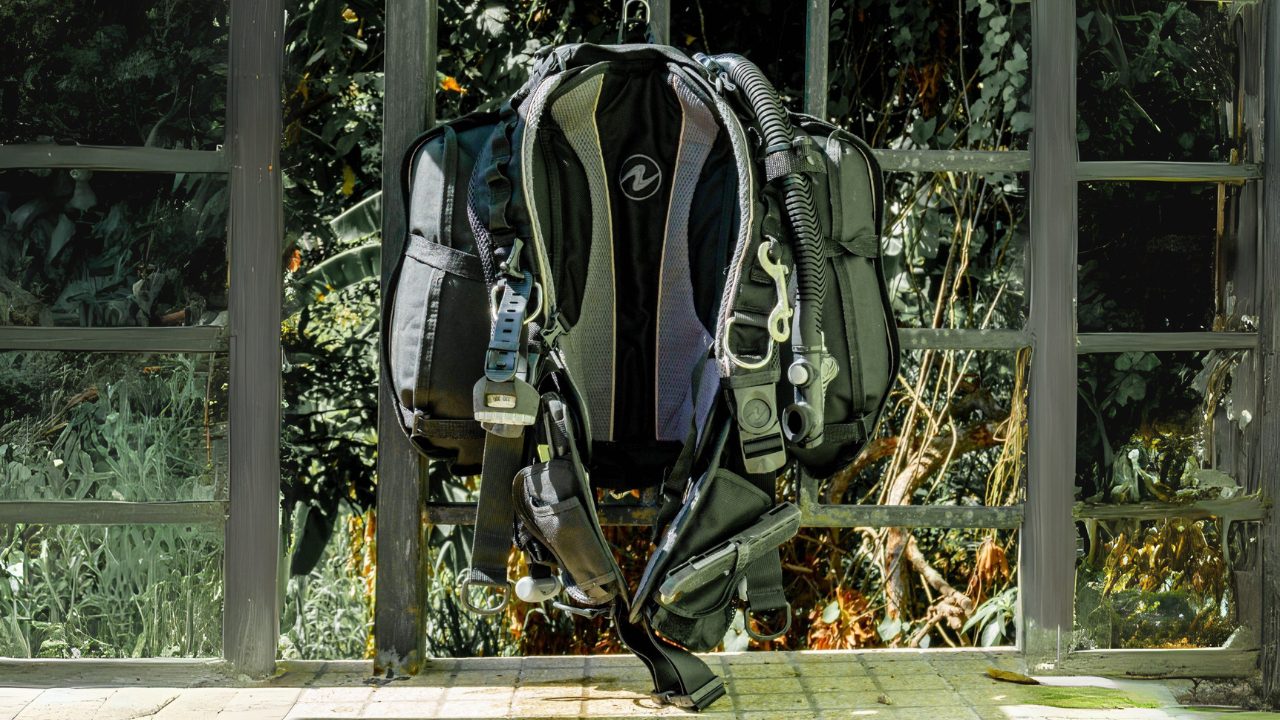
Essential Scuba Diving Gear Checklist
Personal Equipment: Mask, fins, snorkel, wetsuit/exposure protection
Life Support Systems: BCD, regulator system, scuba tank, dive computer
Safety Equipment: Surface marker buoy (SMB), cutting tool, dive light
Optional Gear: Underwater camera, dive slate, gear bag
Primary Scuba Equipment
Your window to the underwater world. A properly fitting diving mask creates a comfortable, watertight seal without pressure from the strap.
- Tempered glass lenses for safety
- Silicone skirt for comfort and durability
- Low-volume design for easier clearing
Transform your leg power into efficient underwater propulsion. Choose between open-heel and full-foot designs based on your diving environment.
- Open-heel for versatility and protection
- Full-foot for warm water efficiency
- Proper fit prevents cramps and blisters
Thermal protection is crucial since water conducts heat 25 times faster than air. Choose thickness based on water temperature.
- 3mm for tropical waters (24°C+)
- 5mm for moderate temperatures (18-24°C)
- 7mm for cooler conditions (13-18°C)
Controls your buoyancy and secures your tank. Choose between jacket-style and back-inflation designs based on diving position preferences.
- Jacket-style for surface comfort
- Back-inflation for streamlined positioning
- Proper fit when inflated and deflated
Delivers breathable air from your tank. A complete regulator system includes first stage, primary second stage, octopus, pressure gauge, and BCD inflator.
- Reliability is paramount for safety
- Balanced first stage for consistent performance
- Comfortable second stage breathing
Modern dive computers are essential safety equipment, tracking depth, time, nitrogen absorption, and decompression status.
- No-decompression limit monitoring
- Ascent rate warnings
- Dive log and planning features
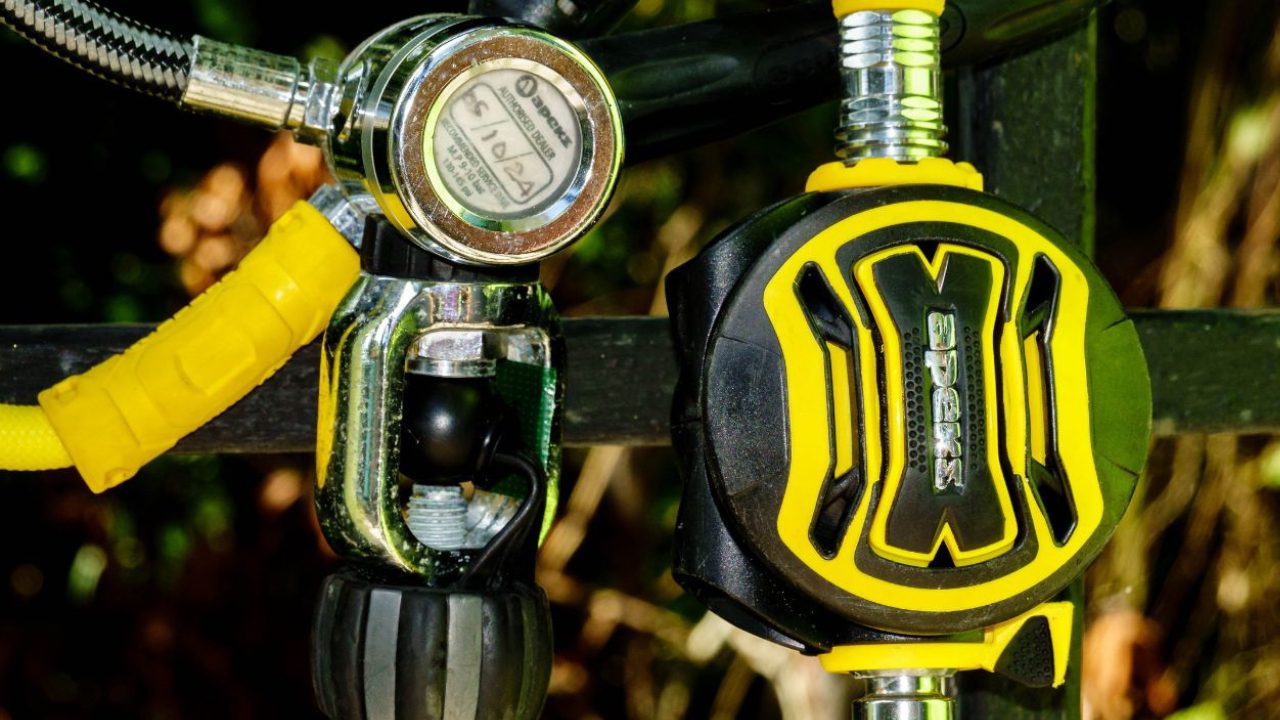
Scuba Gear Price Quick Facts
Understanding typical costs for essential scuba diving gear helps you budget effectively and make informed purchasing decisions.
| Equipment | Budget Range | Mid-Range | Premium | Purchase Priority |
|---|---|---|---|---|
| Diving Mask | ฿1,500-3,000 | ฿3,000-6,000 | ฿6,000-12,000 | Buy First |
| Fins | ฿1,000-2,500 | ฿2,500-5,000 | ฿5,000-10,000 | Buy First |
| Wetsuit (3-5mm) | ฿3,000-6,000 | ฿6,000-12,000 | ฿12,000-25,000 | Buy First |
| Dive Computer | ฿6,000-12,000 | ฿12,000-25,000 | ฿25,000-50,000 | Buy First |
| BCD | ฿6,000-12,000 | ฿12,000-20,000 | ฿20,000-35,000 | Rent First |
| Regulator System | ฿12,000-20,000 | ฿20,000-35,000 | ฿35,000-60,000 | Rent First |
| Surface Marker Buoy | ฿500-1,000 | ฿1,000-2,000 | ฿2,000-3,500 | Buy First |
| Cutting Tool | ฿300-800 | ฿800-1,500 | ฿1,500-3,000 | Buy First |
| Dive Light | ฿800-2,000 | ฿2,000-4,000 | ฿4,000-8,000 | Nice to Have |
Essential Safety Equipment
| Safety Item | Purpose | Priority Level | Price Range | Key Features |
|---|---|---|---|---|
| Surface Marker Buoy (SMB) | Surface signaling and safety | Essential | ₿800-2,500 | Bright color, oral inflation, durable material |
| Cutting Tool | Entanglement release | Essential | ₿500-2,000 | Corrosion resistant, easy access, secure attachment |
| Dive Light | Primary illumination | Important | ₿1,000-5,000 | LED technology, rechargeable, backup light |
| Underwater Slate | Communication tool | Nice to Have | ₿300-1,000 | Waterproof, easy writing, secure attachment |
Gear Selection and Fitting Guide
Place the mask against your face without using the strap, then inhale gently through your nose. A well-fitting mask will stay in place using just the suction from your gentle inhalation. If air leaks in, try another style or size.
Fins should fit snugly but not tight enough to cause cramps. For open-heel fins with boots, ensure the heel strap holds securely without pressure points. Full-foot fins should fit like a comfortable shoe with no sliding movement.
A properly fitting wetsuit should be snug against your skin with minimal water movement inside. Check for flexibility at joints and ensure no binding at the neck, wrists, or ankles. Thickness should match your diving environment’s water temperature.
Equipment Maintenance and Care
Proper maintenance ensures your essential scuba diving gear works correctly when you need it most—underwater. After every dive, especially in saltwater:
- Rinse all equipment thoroughly with fresh water
- Allow gear to dry completely before storage
- Store in a cool, dry place away from direct sunlight
- Check for signs of wear or damage regularly
- Service life-support equipment according to manufacturer recommendations
Building Your Kit: Purchase Priorities
Personal Items Worth Buying First
- Mask, fins, and snorkel: For comfort, hygiene, and proper fit
- Exposure protection: Wetsuit appropriate for your diving environment
- Dive computer: Critical for safety and dive planning
- Surface marker buoy: Essential safety equipment
Equipment to Consider Renting Initially
- BCD: Try different styles before investing
- Regulator system: Ensure proper maintenance without ownership responsibility
- Tanks: Heavy to transport and require regular testing
Rental gear allows you to try different configurations and brands before making significant investments in your essential scuba diving gear collection.
Confused about essential scuba diving gear? Our experienced team provides personalized equipment guidance to ensure you make the right choices for your diving adventures!
At La Bombona Diving, we understand that selecting the right gear can be overwhelming for new divers. Our instructors help you understand what equipment you need, when to buy versus rent, and how to maintain your investment properly.
- Expert gear consultations included with courses
- Try different equipment during training
- Professional maintenance and service advice
- Equipment recommendations for Koh Tao diving
- Small class sizes for personalized attention
- Modern, well-maintained rental equipment
- Multiple certification pathways available
- Ongoing support for gear decisions
Start your diving journey with proper equipment knowledge and expert instruction!
Learn with Expert Instructors – Open Water Course
Open Water Certification ฿11,000 | 4 ocean dives over 4 days
Equipment guidance and try-before-you-buy recommendations included
Frequently Asked Questions
Dive with LBD: Your Gateway to Underwater Exploration
Whether you’re a curious beginner or a seasoned pro, our school is your portal to the wonders of scuba diving. Join us into the world beneath the waves.
READY TO GET STARTED?
Check our diving courses in Koh Tao
